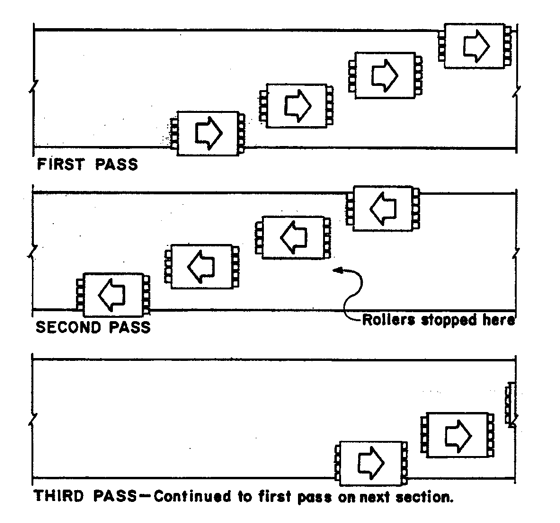Section 15: Rolling the Aggregate
Anchor: #i1007789Introduction
The aggregate should be rolled immediately with approved self-propelled pneumatic-tired rollers. Steel-wheeled rollers are not recommended because they can crush the aggregate. Immediate rolling provides better embedment and assists rapid wetting of the aggregate by the binder. There should be enough rollers to cover the entire mat width in one pass (one direction). Rolling should be in a staggered pattern making a minimum of five passes for asphalt cement or three passes for asphalt emulsions. Additional rolling may be required during cooler air temperatures. If rollers are unable to keep up with the spreader, asphalt application should stop until rollers catch up, or additional rollers should be furnished.
The distributor controls the overall production because no other piece of equipment can begin to function until the distributor has applied binder to the surface. Therefore, to ensure a high standard of quality control, the spreader and roller operations must be able to keep up with the production of the distributor. The number of rollers, the rolling time, and keeping pace with the distributor are critical for a successful seal coat.
Anchor: #i1007804Rolling Pattern
The rolling pattern used for seal coats will depend largely on the number and types of rollers. For a 12-foot wide asphalt shot, the most efficient rolling system will typically involve three or four pneumatic rollers. With this number of rollers, it is possible to provide coverage with three passes (acceptable for emulsions): one forward, one in reverse, and the final pass forward extending into the first pass of the next section. It is usually better to have the rollers operating continuously rather than sitting idle. Normally, more rolling is better unless aggregate degradation is occurring.
When three or four pneumatic rollers are used, the rollers should be staggered in an echelon pattern. The lead roller is usually on the inside, and each of the others offset approximately one-third the roller width. The sketch in Figure 8‑8 illustrates the echelon pattern.
Figure 8-8. Illustration of Echelon Rolling Pattern.
Anchor: #i1007829Checking the Rolling Pattern
The rolling pattern should be checked to verify that complete coverage and proper embedment are achieved. Rollers should cover both edges completely as well as the center of the lane. After the rollers have completed one section, the aggregate orientation should be visually evaluated. If the aggregate particles are lying in their flattest dimension, the rolling is adequate. If many of the aggregate particles are still situated upright, additional rolling should be required. The rolling operation should be monitored carefully to ensure that none of the roller operators stop and start too quickly causing scuffing on the fresh seal.
